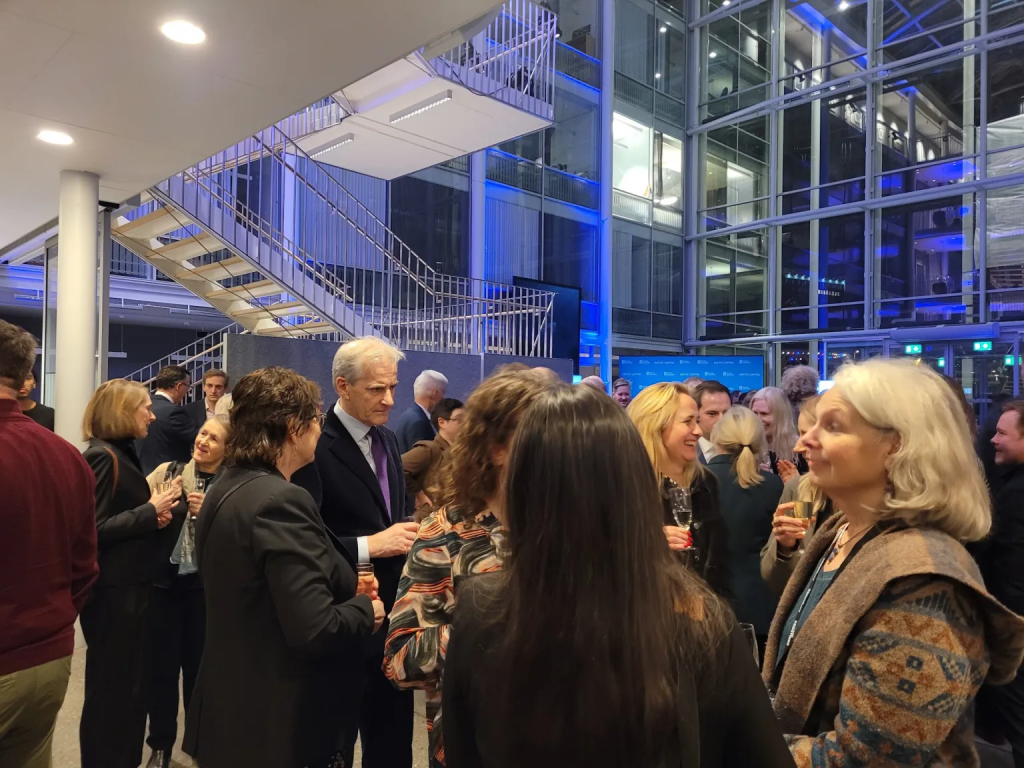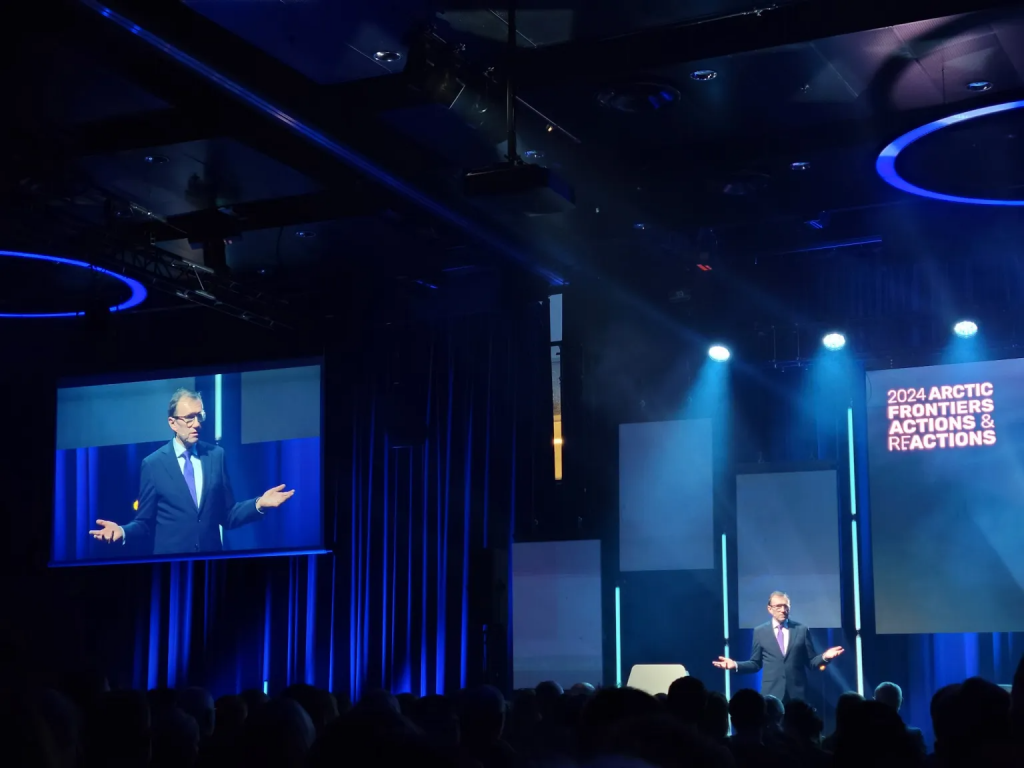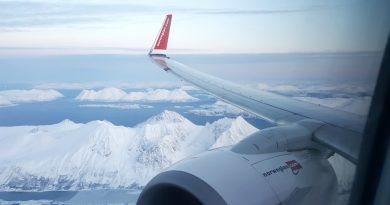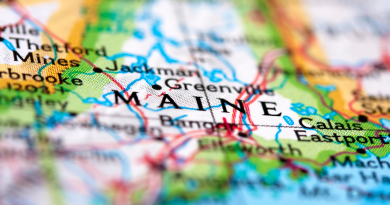Blog: Arctic Frontiers kicks off to rain falling on snow

With climate change starting to affect the very conferences that discuss them, concerns can no longer be confined to a Powerpoint slide.
This week, I’m in Tromsø, Norway – the self-proclaimed “capital of the Arctic” – for the Arctic Frontiers conference. The last time I came to this conference was in 2014, when it was still held at the University of Tromsø a couple miles from town. Later that year, Clarion the Edge opened downtown – the upscale venue where the conference is now held. The academic setting and mid-afternoon cafeteria skolebrød are now a thing of the past, replaced by hotel ballrooms with stage lighting and lavish lunches with snow crab leg buffets.
The cast of characters has changed since I first started coming to north Norway, too. On the one hand, Norwegian dignitaries like Prime Minister Jonah Gahr Store and Foreign Minister Espen Barth Eide still grace the plenary stages. Afterwards, they can be found mingling with other attendees during coffee breaks – a type of socializing that always blows my mind as an American who would have a hard time getting close to my state governor, let alone the nation’s president.
On the other, there are hardly any Russians to be found, which is a sea change from a decade ago. While there continue to be delegations from the stalwart Asian Arctic observer states of China, Japan, and South Korea, they are now joined by Norway’s Ambassador to India and his colleague, reflecting India’s growing interest in the Arctic (spurred, ironically, by its growing purchase of Arctic oil from Russia as the country is cut off from selling directly to European markets). As it turns out, one Norwegian colleague I caught up with at Arctic Frontiers had just returned from a short conference in New Delhi held on the Arctic.
Climate change rears its head
Perhaps the starkest difference between Arctic Frontiers now and a decade ago, though, is the weather. Climate change is usually something from which conference delegates tend to feel insulated, gathering inside heated buildings in urban centers that are usually well connected by air travel. But that was not the case in Tromsø.
Starting on Sunday night, an unprecedented strong and warm storm tore through northern Norway, closing bridges, roads, and schools, shutting down the airport, and causing dozens of flights to be cancelled. This led many conference speakers to have to participate remotely from airport lounges. Rather than the expected confetti of soft white snowflakes falling in the Arctic in January, instead centimeters of gray rain fell on snow-covered streets and sidewalks, turning them into dangerously icy pitches. I was coming back to Tromsø from a weekend skiing in the Lyngen Alps two hours south of the city and literally had to slide on all fours in order to cross the sloped street, pushing my 60 pounds of luggage in front of me. On the coast, record-high winds up to 143 mph (230 km/h) were recorded, damaging infrastructure and spurring avalanches.

Ten years ago, in snow-white Tromsø, I never would have imagined that I’d one day encounter the rain-on-snow events that are now increasingly pounding the Arctic. These sudden switches that reverse the middle of winter to early fall in an instant are a nightmare for everyone, from conference organizers to commuters, tourists, and reindeer herders. Visitors who come seeking northern lights and winter wonderlands – many of them now all the way from Asia – instead find cloudy skies and slush-filled streets. With air temperatures of 7°C (45°F), it was likely warmer in Tromsø than in many of the places from which tourists had arrived. Yet once the temperature drops again and rain freezes atop snow, it creates a hard layer that reindeer can’t penetrate through to the shrubs below, increasing the risk of starvation. The increasing climate volatility threatens both humans and animals alike.
In his remarks today, Foreign Minister Espen Barth Eide indicated that when Norway’s High North policy was released in 2006, there was hope that relations with Russia would improve and that there would be an oil and gas bonanza in the Arctic. Now, he observed, both things had changed.
First, while the Arctic Council’s member states had long worked hard to shield the body’s work from the “cold winds,” he reflected, “With the full-scale invasion of Ukraine, that is no longer possible and there is no reason to think it will change anytime soon.”
Second, he added, “Oil and gas is not going to be the dominant theme. The dominant theme will be all that follows from the green transition.”

With climate change washing away winter in an instant this week in Tromsø, moving away from fossil fuels can’t happen quickly enough. Yet, ironically, the effects of climate change did not seem too high on the politicians’ agendas during their speeches, even though they could be seen right outside the conference – and even heard inside it, as the rattling of windows and the rumbling of snow tires driving on rainy streets rather than snow-covered asphalt made jarringly clear.
In his cautionary remarks, Professor Oran Young of the University of California – Santa Barbara lamented, “I worry about the narratives of geopolitics and securitization deflecting from greater concerns.” One of those is climate change. While the war in Ukraine will one day be over, the effects of a warming Arctic are baked in for decades, if not centuries. The region must learn to deal simultaneously with crises both immediate and long-term. With climate change starting to affect the very conferences that discuss them, concerns can no longer be confined to a Powerpoint slide.
Related stories from around the North:
Canada: 2023 was warmest year on record “by a huge margin,” says WMO, Eye on the Arctic
Finland : Record average September temperatures stretch into Northern Finland, Eye on the Arctic
Greenland: Alarming, above-average ice loss in Greenland due to rising temperatures, Eye on the Arctic
Norway: Commercial mining could disrupt deep-sea carbon storage, says study, The Independent Barents Observer
Sweden: After icy record last week – Kvikkjokk is now Sweden’s warmest place, Radio Sweden
United States: Anchorage ‘Pandemic of snow’ sets record for earliest arrival of 100 inches of snow, The Associated Press



